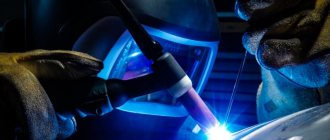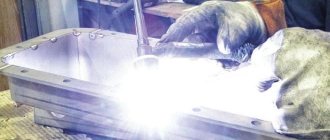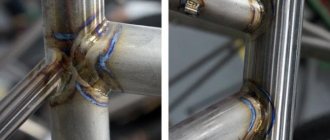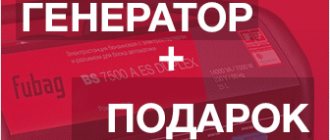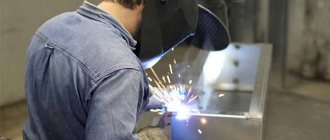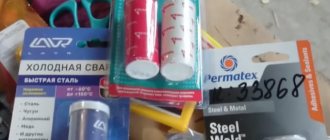During critical repairs of aluminum parts and installation of profile frames, electrodes cannot be used to make reliable connections. When welding aluminum semi-automatically, the seams are of high quality. It is possible to weld light metal by electric arc welding in argon or carbon dioxide using special refractory electrodes and filler wire, but semi-automatic welding is the most effective and reliable method of processing aluminum alloys.
If aluminum is welded semi-automatically without gas, protective fluxes are used or a special multi-component flux-cored wire is used, which, when heated, creates a gas cloud that prevents oxidation.
Features of semi-automatic aluminum welding
Light metal is difficult to weld due to the oxide that forms on the surface when exposed to air. The oxide film must first be removed from the parts; depending on the alloy, it burns out at +2050 – +2200°C, and the melting point of aluminum is only +660°C.
Aluminum alloys have high thermal conductivity: parts quickly warm up when heated and immediately cool down as soon as the heat source disappears. During heat treatment, internal stresses arise in aluminum workpieces, causing cracks to appear in the seam.
When deciding how to weld aluminum semi-automatically, it is necessary to provide for preliminary heating of the workpieces with a gas burner to +150 - +190°C. Experts use linings that remove heat; they prevent the aluminum from getting too hot and cooling quickly. It is important to adhere to the welding mode so as not to burn through thin parts.
Types of wire
Wire for semi-automatic welding of aluminum is a filler material. During the welding process, it melts and becomes part of the seam. Therefore, the main requirement for its selection is that the chemical composition must be close to the chemical composition of the material that will be welded. Also, its melting temperature should be either the same as the elements being welded or slightly lower.
Aluminum welding wire for semi-automatic machines is produced by Russian and foreign manufacturers Ø 0.8 ÷ 3.2 mm. Welding of aluminum with wire is carried out with the grades indicated in the table.
| Brand according to international classification | Domestic analogue |
| OK Autrod 1070 (18.01) | St. - A85, St. - A97, St. - Amts |
| OK Autrod 1450 (11/18) | St. - 1201 |
| OK Autrod 4043 (18.04) | St. – AK5, St. – AK6 |
| OK Autrod 5183 (18.16) | St. – AMg5 |
| OK Autrod 5356 (18.15) | St. – AMg3 |
Wire for semi-automatic welding of aluminum according to another common classification EN ISO 18273 can be marked ER 4043, ER 5356. These are the most commonly used filler materials for welding cast alloys such as AD31, AD33 and AD35, if they do not require an anodizing operation. Supplied in coils or on cassettes of different weights.
Semi-automatic welding of aluminum without gas is carried out using flux-cored wire; it is also called self-shielding. It has a tubular structure inside which there is a powdery filler. It simultaneously performs several functions - deoxidizes, alloys, protects from harmful effects of air, forms a seam, etc.
The choice of diameter and brand of self-shielding wire depends on the thickness of the products that will be welded and the composition of the aluminum alloy.
Which semi-automatic machine is suitable for aluminum welding
Manufacturers offer a wide range of household and welding equipment. There are compact models that generate current of various parameters.
Functional
When choosing a semi-automatic welding machine for welding aluminum for a private workshop or car service, it is better to choose devices with the TIG function that generate high-frequency pulsed current. They are equipped with a “PULSE” mode. Working with them reduces the risk of burns and maintains a stable short arc. With TIG inverters without a pulse unit, the work is three times slower, but the connection quality will also be high.
Simple inverters with MIG/MAG functions are used for domestic purposes; argon and carbon dioxide can be connected to them. It is difficult to make a high-quality connection with such inverters; they are designed for low currents. There is no need to pay for additional features. The more complex the equipment, the greater the risk of failure.
Advantages and disadvantages
The advantages of duralumin during welding include:
- If you follow the welding technology, you can get an even and high-quality seam , and the metal can withstand heavy loads while being light in weight.
- To weld duralumin, you can use several welding technologies : argon welding and semi-automatic welding, which will be chosen by understanding the factors and conditions of the work.
- It is quite easy to select suitable electrodes for the work . Electrodes such as OZA-1, OZA-2, OK96.20, OZANA-1, OZANA-2 are suitable for welding.
- No serious labor costs for preparatory procedures.
- Welding does not require serious specialist classification.
But this process also has certain disadvantages:
- Welding of duralumin is characterized by low resistance to corrosion , and after welding, its technical characteristics deteriorate.
- The welding process is quite complex : it requires great care and precision, since even a small error negatively affects the quality of the products.
- Difficulties may arise with the selection of electrodes due to the impossibility of accurately determining the grade of duralumin.
- Forming a roller is quite difficult , since the metal is quite fluid.
- To simplify the work process and reduce welding time, it is necessary to use flux or shielding gas . Flux will be applied to the surface of the part being welded to protect the area from the aggressive influence of the external environment and improve the quality of the connection. The intended purpose of using inert gases in welding will be similar.
- High-quality welding of duralumin is a fairly expensive procedure ; it allows you to obtain a strong and reliable connection when using expensive consumables, for example, argon.
- If high-speed welding is used, it is very difficult to control the quality of the seam.
Setting up a semi-automatic welding machine
There are no universal settings for the operation of a semi-automatic machine for aluminum. Welders focus on the thickness of the workpiece. In everyday life, 2-mm aluminum is often welded; for this, the operating voltage is set to 15 V, the current, depending on the composition of the alloying additives, is regulated in the range from 100 to 150 amperes. The wire feed speed is adjusted based on personal welding experience. These are average settings, they are adjusted as work progresses. MIG welding of aluminum is carried out with reverse polarity: the negative terminal is connected to the workpiece, and the positive terminal is connected to the feed nozzle.
Soldering silumin
Decorative parts and those that do not experience stress can be soldered with a gas torch, the metal is heated to 200°C. Soldering silumin with thin walls is done with a soldering iron with a powerful tip. Metal linings are used to protect against oxidation. Only the work area is left uncovered.
Solders used:
- ER4043 – additive for cast aluminum alloyed with silicon and magnesium grades AD31, AD33, AD35;
- Harris52 – solder for aluminum with flux additives;
- HTS2000 is a Chinese analogue of Harris52.
Welding technology
At home, the workpieces are cooked using a household semiautomatic device with direct current of reverse polarity. You can make a pretty decent seam with your own hands if you follow the technology:
- First you need to prepare the equipment. Select a tip for a semi-automatic welding machine for aluminum welding. It should be a few mm larger than the wire size.
- The parts in the working area are cleaned to a shine using a grinding machine or a metal brush.
- Select the operating mode taking into account the thickness of the workpiece and alloy. You can use the tuning tables specified by GOST.
- The supply of shielding gas is turned on a few seconds before ignition of the arc so that a protective cloud of gas is formed.
- Light the arc, maintaining the distance between the melt pool and the nozzle no more than 15 mm, the minimum gap is 1 cm.
- The additive supply rate is adjusted gradually, do not immediately set to maximum, make sure that the metal is well boiled.
- The arc is conducted evenly, forming a uniform surfacing bead.
- At the end of the work, the arc is first smoothly pulled to the side, only after that the current is turned off. The supply of protective gas is not stopped for 10-20 seconds while the work area cools down. It protects the molten metal from exposure to oxygen.
Troubleshooting connection difficulties
To prevent this from happening, the surfaces to be welded are first cleaned by etching or mechanical cleaning with a metal brush. Cleaned parts are stored for no more than three hours.
An effective method for film removal is cathode sputtering, where the metal is bombarded with ions, cleaning the surface. The method is used in industry.
Fluxes are also used that dissolve the film and convert it into volatile compounds.
For welding alloys that do not contain magnesium, such as silumin, AN-A1 flux is used. For duralumin, AN-A4 flux is used.
In addition, before welding, the surfaces are cleaned of contamination with solvents RS-1, RS-2.
Useful tips
To weld metal with a high-quality semi-automatic machine, you should listen to the professionals:
- To clean aluminum, it is not advisable to use metal brushes that have been used to clean other metals; it is better to knit a new one, without foreign inclusions. It is better to use chemical treatment of the metal with acid followed by washing.
- When welding aluminum semi-automatically in argon using a four-cycle pulsed current, the metal warms up faster, creating a high temperature in the melt zone. The likelihood of a residual oxide layer getting into the seam is reduced.
- Internal linear voltages can be reduced by reducing the current towards the final stage of welding. They begin work, on the contrary, at maximum mode in order to break through the oxidized layer.
- When working semi-automatically in a carbon dioxide environment, do not make sudden movements; the nozzle should melt evenly.
- When a protective atmosphere is used, the work area is protected from drafts so that gusts of wind do not blow the gas cloud away.
- When working, it is necessary to observe safety precautions, use special clothing, personal protective equipment, including for the respiratory system; some alloying additives have a toxic effect on the body.
Semi-automatic welding of aluminum at home requires certain skills. Beginners can weld metal poorly, then it will warp and the seam will crack. Before you take on important connections, you need to “get your teeth into it,” learn how to maintain the optimal distance, and develop a speed limit.
Properties and weldability of duralumin
The physical properties of duralumin are similar to aluminum. The light alloy is difficult to weld; it is chemically active, oxidizes in air, and forms a strong oxide film. Welding of duralumin is often carried out in garages and small workshops. It is necessary to take into account the physical properties of the alloy: high density, the presence of an oxide film, fluidity.
When working with electrodes, the grade of duralumin is specified, because different additives are used for alloying: iron, manganese, copper, silicon. During the production of parts, duralumin is additionally strengthened, the metal loses its ductility. Dural is cooked at temperatures up to 300°C, using flux or a protective atmosphere, since the metal is prone to oxidation.
Preparing for work
The control panel of a semi-automatic welding machine without gas contains several control elements, including:
- semi-automatic welding current switch;
- adjustment of filler wire feed speed;
- on/off timer for spot soldering;
- mount for welding gun.
All welding machines that allow joining metals in carbon dioxide must go through a series of stages in preparation for work:
- Checking equipment grounding. According to fire safety and the GOST standard, all welding equipment must be connected to a grounding conductor.
- Network check. Semi-automatic devices are very vulnerable to various voltage deviations in the electrical network.
- Selecting the operating mode. The equipment is configured for a specific type of welding work.
- Diagnostics of the performance of the torch and filler wire supply system.
- Checking the quality of wire. The filler material must not have any peeling, damage or dents.
Requirements
You can weld a seam using welding equipment by observing certain requirements:
- Do not touch the electrode to the surface being processed when igniting the arc.
- Before supplying gas, the burner nozzle should be warmed up. After 15 seconds, you can open the gas valve.
- After stopping the supply of electricity to the electrode, wait 10 seconds and only then turn off the gas valve.
If the work is carried out at home, you can use a consumable electrode rather than a tungsten electrode.
